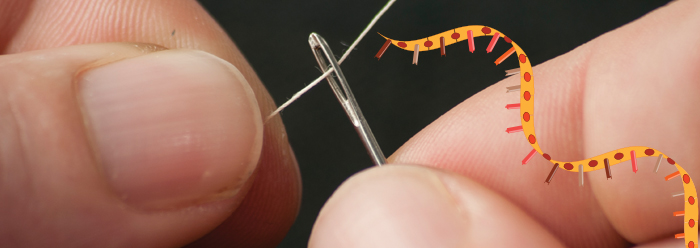What does it take to slip a tiny thread through the eye of a needle and then use that thread to accomplish a purpose? Chimpanzees and other apes can’t do this. It takes fine, precise motion. Three examples of using needle and thread point to God as a super-genius Creator.
In her later years, my grandmother sometimes asked me to thread a needle for her because her eyesight had dimmed. A sewing thread can enter only one place—the needle’s eye—to fulfill its purpose. Maybe the sewer then uses it to hem a pant leg, stitch a seam, or embroider a garment. Whoever properly manipulates thread must have sight, make precise motions, and imagine the end product.
Certain machines use thread to create cloth mechanically. In handlooms, the weaver tosses a shuttle that carries a bobbin of weft thread between separated crosswise warp threads. The weaver then swaps thread angles before tossing the shuttle back to the other side. Some automated factory looms replace shuttles with slender rods called rapiers. One rapier brings the thread halfway across, then passes its thread to a second rapier that grabs the thread to pull it all the way across the cloth width. They hand off the thread something like 1,000 times a minute.
The factory loom cannot see what it is doing, nor can it imagine an end product, but it can make a precise motion. Who could watch an industrial loom in action without immediately perceiving that whoever designed and built the loom had sight, precise motion, and a mindful purpose? In other words, the tools that humans make reflect human qualities and abilities. Did God make any threading machines?
Yes, He did, and without them our bodies would die in minutes. But His machines handle “threads” many times smaller than a human hair. If an RNA molecule, which carries the information needed to construct a protein, is like a thread, then the ribosome is like a needle’s eye. The slender RNA winds through the ribosome, which helps translate the RNA’s information.
What happens when bad thread enters a factory loom? A machinist stops the loom, diagnoses the problem, and devises a solution. Maybe a super-genius could devise a factory with no people, where machines diagnose and solve their own problems. Researchers recently discovered such machines working with ribosomes to correct faulty RNA.
Misshapen RNA strands stall inside their ribosomes. In yeast, this catches the attention of the oddly named Ski complex. Other organisms have similar complexes. Each Ski complex includes ribosome clamps, an on/off switch, and attachment points for an enzyme called helicase. The Ski2 segment of Ski complex clamps onto the stalled ribosome. It then pushes a dangling end of the RNA “thread,” called an overhang, into a channel that travels through helicase. Helicase likely threads bad RNA strands into the “eye”—a small opening—of a nearby exosome for recycling.
In a study published in the journal Science, a German and French team worked out the positions of the thousands of atoms that make up the ribosome, RNA, and Ski complex. The study authors wrote, “We observe that the mRNA 3′ overhang is threaded directly from the small ribosomal subunit to the helicase channel of Ski2.”1
Sighted, precise, imaginative people make factory looms that quickly and reliably slip threads through tight spots—but the machines sometimes need technicians. Similar reasoning demands a micro-sighted, precise-to-the-atom, and imaginative super-genius to make molecular machines that—like automated problem-solving technicians—thread flawed RNA strands into recyclers. Truly, our God is the ultimate Genius.
Reference
- Schmidt, C. et al. 2016. The cryo-EM structure of a ribosome–Ski2-Ski3-Ski8 helicase complex. Science. 354 (6318): 1431-1433.
* Mr. Thomas is Science Writer at the Institute for Creation Research and earned his M.S. in biotechnology from Stephen F. Austin State University.




